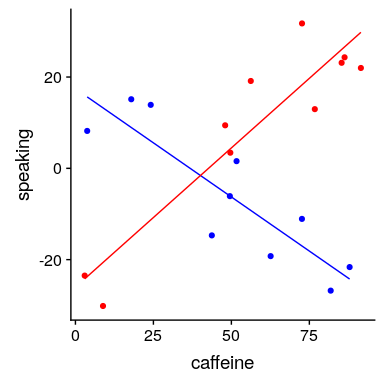## 14.3 变量之间的相互作用
在前面的模型中,我们假设两组的学习时间对成绩的影响(即回归斜率)是相同的。但是,在某些情况下,我们可以想象一个变量的效果可能会因另一个变量的值而不同,我们称之为变量之间的 _ 交互 _。

图 14.6 咖啡因与公共演讲的关系
让我们用一个新的例子来问这个问题:咖啡因对公众演讲的影响是什么?首先,让我们生成一些数据并绘制它们。从图[14.6](#fig:CaffeineSpeaking)来看,似乎没有关系,我们可以通过对数据进行线性回归来确认:
```r
# perform linear regression with caffeine as independent variable
lmResultCaffeine <- lm(speaking ~ caffeine, data = df)
summary(lmResultCaffeine)
```
```r
##
## Call:
## lm(formula = speaking ~ caffeine, data = df)
##
## Residuals:
## Min 1Q Median 3Q Max
## -33.10 -16.02 5.01 16.45 26.98
##
## Coefficients:
## Estimate Std. Error t value Pr(>|t|)
## (Intercept) -7.413 9.165 -0.81 0.43
## caffeine 0.168 0.151 1.11 0.28
##
## Residual standard error: 19 on 18 degrees of freedom
## Multiple R-squared: 0.0642, Adjusted R-squared: 0.0122
## F-statistic: 1.23 on 1 and 18 DF, p-value: 0.281
```
但现在让我们假设,我们发现研究表明焦虑和非焦虑的人对咖啡因的反应不同。首先,让我们分别为焦虑和非焦虑的人绘制数据。

图 14.7 咖啡因与公共演讲的关系,数据点颜色代表焦虑
从图[14.7](#fig:CaffeineSpeakingAnxiety)可以看出,两组人的言语和咖啡因之间的关系是不同的,咖啡因改善了无焦虑人群的表现,降低了焦虑人群的表现。我们想创建一个解决这个问题的统计模型。首先,让我们看看如果在模型中包含焦虑会发生什么。
```r
# compute linear regression adding anxiety to model
lmResultCafAnx <- lm(speaking ~ caffeine + anxiety, data = df)
summary(lmResultCafAnx)
```
```r
##
## Call:
## lm(formula = speaking ~ caffeine + anxiety, data = df)
##
## Residuals:
## Min 1Q Median 3Q Max
## -32.97 -9.74 1.35 10.53 25.36
##
## Coefficients:
## Estimate Std. Error t value Pr(>|t|)
## (Intercept) -12.581 9.197 -1.37 0.19
## caffeine 0.131 0.145 0.91 0.38
## anxietynotAnxious 14.233 8.232 1.73 0.10
##
## Residual standard error: 18 on 17 degrees of freedom
## Multiple R-squared: 0.204, Adjusted R-squared: 0.11
## F-statistic: 2.18 on 2 and 17 DF, p-value: 0.144
```
在这里,我们看到咖啡因和焦虑都没有明显的效果,这看起来有点令人困惑。问题是,这一模型试图符合两组人对咖啡因说话的同一条线。如果我们想使用单独的行来拟合它们,我们需要在模型中包含一个 _ 交互 _,这相当于为两个组中的每个组拟合不同的行;在 r 中,这由符号表示。
```r
# compute linear regression including caffeine X anxiety interaction
lmResultInteraction <- lm(
speaking ~ caffeine + anxiety + caffeine * anxiety,
data = df
)
summary(lmResultInteraction)
```
```r
##
## Call:
## lm(formula = speaking ~ caffeine + anxiety + caffeine * anxiety,
## data = df)
##
## Residuals:
## Min 1Q Median 3Q Max
## -11.385 -7.103 -0.444 6.171 13.458
##
## Coefficients:
## Estimate Std. Error t value Pr(>|t|)
## (Intercept) 17.4308 5.4301 3.21 0.00546 **
## caffeine -0.4742 0.0966 -4.91 0.00016 ***
## anxietynotAnxious -43.4487 7.7914 -5.58 4.2e-05 ***
## caffeine:anxietynotAnxious 1.0839 0.1293 8.38 3.0e-07 ***
## ---
## Signif. codes: 0 '***' 0.001 '**' 0.01 '*' 0.05 '.' 0.1 ' ' 1
##
## Residual standard error: 8.1 on 16 degrees of freedom
## Multiple R-squared: 0.852, Adjusted R-squared: 0.825
## F-statistic: 30.8 on 3 and 16 DF, p-value: 7.01e-07
```
从这些结果中,我们发现咖啡因和焦虑都有显著的影响(我们称之为 _ 主要影响 _),以及咖啡因和焦虑之间的相互作用。图[14.8](#fig:CaffeineAnxietyInteraction)显示了每组的独立回归线。

图 14.8 公众演讲和咖啡因之间的关系,包括与焦虑的互动。这将生成两条线,分别为每个组建模坡度。
有时我们想比较两个不同模型的相对拟合,以确定哪个模型更好;我们将其称为 _ 模型比较 _。对于上面的模型,我们可以使用 r 中的`anova()`命令比较模型的拟合优度(有无交互作用):
```r
anova(lmResultCafAnx, lmResultInteraction)
```
```r
## Analysis of Variance Table
##
## Model 1: speaking ~ caffeine + anxiety
## Model 2: speaking ~ caffeine + anxiety + caffeine * anxiety
## Res.Df RSS Df Sum of Sq F Pr(>F)
## 1 17 5639
## 2 16 1046 1 4593 70.3 3e-07 ***
## ---
## Signif. codes: 0 '***' 0.001 '**' 0.01 '*' 0.05 '.' 0.1 ' ' 1
```
这告诉我们,有很好的证据表明,比起没有交互作用的模型,更倾向于有交互作用的模型。在这种情况下,模型比较相对简单,因为这两个模型是 _ 嵌套的 _——其中一个模型是另一个模型的简化版本。与非嵌套模型的模型比较可能会变得更加复杂。
- 前言
- 0.1 本书为什么存在?
- 0.2 你不是统计学家-我们为什么要听你的?
- 0.3 为什么是 R?
- 0.4 数据的黄金时代
- 0.5 开源书籍
- 0.6 确认
- 1 引言
- 1.1 什么是统计思维?
- 1.2 统计数据能为我们做什么?
- 1.3 统计学的基本概念
- 1.4 因果关系与统计
- 1.5 阅读建议
- 2 处理数据
- 2.1 什么是数据?
- 2.2 测量尺度
- 2.3 什么是良好的测量?
- 2.4 阅读建议
- 3 概率
- 3.1 什么是概率?
- 3.2 我们如何确定概率?
- 3.3 概率分布
- 3.4 条件概率
- 3.5 根据数据计算条件概率
- 3.6 独立性
- 3.7 逆转条件概率:贝叶斯规则
- 3.8 数据学习
- 3.9 优势比
- 3.10 概率是什么意思?
- 3.11 阅读建议
- 4 汇总数据
- 4.1 为什么要总结数据?
- 4.2 使用表格汇总数据
- 4.3 分布的理想化表示
- 4.4 阅读建议
- 5 将模型拟合到数据
- 5.1 什么是模型?
- 5.2 统计建模:示例
- 5.3 什么使模型“良好”?
- 5.4 模型是否太好?
- 5.5 最简单的模型:平均值
- 5.6 模式
- 5.7 变异性:平均值与数据的拟合程度如何?
- 5.8 使用模拟了解统计数据
- 5.9 Z 分数
- 6 数据可视化
- 6.1 数据可视化如何拯救生命
- 6.2 绘图解剖
- 6.3 使用 ggplot 在 R 中绘制
- 6.4 良好可视化原则
- 6.5 最大化数据/墨水比
- 6.6 避免图表垃圾
- 6.7 避免数据失真
- 6.8 谎言因素
- 6.9 记住人的局限性
- 6.10 其他因素的修正
- 6.11 建议阅读和视频
- 7 取样
- 7.1 我们如何取样?
- 7.2 采样误差
- 7.3 平均值的标准误差
- 7.4 中心极限定理
- 7.5 置信区间
- 7.6 阅读建议
- 8 重新采样和模拟
- 8.1 蒙特卡罗模拟
- 8.2 统计的随机性
- 8.3 生成随机数
- 8.4 使用蒙特卡罗模拟
- 8.5 使用模拟统计:引导程序
- 8.6 阅读建议
- 9 假设检验
- 9.1 无效假设统计检验(NHST)
- 9.2 无效假设统计检验:一个例子
- 9.3 无效假设检验过程
- 9.4 现代环境下的 NHST:多重测试
- 9.5 阅读建议
- 10 置信区间、效应大小和统计功率
- 10.1 置信区间
- 10.2 效果大小
- 10.3 统计能力
- 10.4 阅读建议
- 11 贝叶斯统计
- 11.1 生成模型
- 11.2 贝叶斯定理与逆推理
- 11.3 进行贝叶斯估计
- 11.4 估计后验分布
- 11.5 选择优先权
- 11.6 贝叶斯假设检验
- 11.7 阅读建议
- 12 分类关系建模
- 12.1 示例:糖果颜色
- 12.2 皮尔逊卡方检验
- 12.3 应急表及双向试验
- 12.4 标准化残差
- 12.5 优势比
- 12.6 贝叶斯系数
- 12.7 超出 2 x 2 表的分类分析
- 12.8 注意辛普森悖论
- 13 建模持续关系
- 13.1 一个例子:仇恨犯罪和收入不平等
- 13.2 收入不平等是否与仇恨犯罪有关?
- 13.3 协方差和相关性
- 13.4 相关性和因果关系
- 13.5 阅读建议
- 14 一般线性模型
- 14.1 线性回归
- 14.2 安装更复杂的模型
- 14.3 变量之间的相互作用
- 14.4“预测”的真正含义是什么?
- 14.5 阅读建议
- 15 比较方法
- 15.1 学生 T 考试
- 15.2 t 检验作为线性模型
- 15.3 平均差的贝叶斯因子
- 15.4 配对 t 检验
- 15.5 比较两种以上的方法
- 16 统计建模过程:一个实例
- 16.1 统计建模过程
- 17 做重复性研究
- 17.1 我们认为科学应该如何运作
- 17.2 科学(有时)是如何工作的
- 17.3 科学中的再现性危机
- 17.4 有问题的研究实践
- 17.5 进行重复性研究
- 17.6 进行重复性数据分析
- 17.7 结论:提高科学水平
- 17.8 阅读建议
- References
